The revolutionary role of bioelectronics in future human medicine
Hand prostheses that restore tactile sensitivity to amputees. Sensors capable of detecting diseases prior to outbreaks. These applications could soon become part of conventional treatment thanks to microchips implanted in the body. At Fraunhofer IZM, the Technologies for Bioelectronics working group is busy developing ultra-thin biocompatible coatings for bioelectronics implants. The core aim is to enable decade-long functionality of miniature implants without the need for surgical interventions.

Compared to current forms of diagnosis and treatment that are based on conventional pharmaceuticals, new types of neural interfaces will enable targeted stimulation of individual neural fibers. These interfaces will not only have the potential to eliminate numerous side effects, but also to facilitate completely novel treatments – for treating blindness, for example. Innovative encapsulation materials with high biocompatibility allow electronic components to reliably withstand the complex environmental conditions that prevail inside the human body. "Most patients treated with deep brain stimulation for Parkinson's disease tend to be older, but neuronal implants could help people of any age. That's why it's important for these implants to last for decades inside the constantly changing human body," says Joshua Wilson, a research associate in the Technologies for Bioelectronics working group at the Fraunhofer Institute for Reliability and Microintegration IZM.
Demands placed on microchips in the human body
Humidity, salinity and mechanical stress all contribute to making the environment within the body unfavorable for electronic components. The salts and water present within the body may corrode conductive materials, leading to implant failure. Immune reactions mounted against the implant may also result in damage or in encapsulation within scar tissue, resulting in reduced effectiveness. All the reasons mentioned above have led to the contemporary practice of protecting the implant electronics inside hermetically sealed casings. These casings are relatively large and quite inflexible, which makes it extremely difficult to use them in close proximity to the delicate and fragile nerve tissue. The primary solution used at present is to place the casing distal to the treatment site and connect the two using cables, but this approach is known to be limited and prone to failures. Scientists at Fraunhofer IZM have therefore developed various biocompatible polymer and ceramic coatings that are finer than a human hair. Encapsulation in such fine coatings will help to decrease implant volume, allowing implantation in a wider variety of locations in the human body. However, the material, topology and functional scope of the implant may vary depending on the implantation site and application. Fraunhofer IZM scientists are therefore working on a range of materials and techniques that enable reliable, customized solutions for a wide range of miniaturized, implantable medical devices.
Smart prostheses thanks to neural interfaces
One specific project exemplifies the research route from the laboratory to clinical practice and the issues that bioelectronics experts in Berlin will be addressing in the near future. The aim of the "Nerve Repack" project, launched in 2023, is to develop smarter prostheses by fitting them with neural interfaces. There are three major outcomes expected: a prosthesis for forearm amputees, and two exoskeletons for patients with unilateral and bilateral lower limb paralysis. Merging a prosthesis and neural implant enables both transmission of the movement impulse to the prosthesis and a return transmission of signals to the brain, i.e. bidirectional communication. This bidirectional communication in the forearm prostheses will provide tactile feedback and give the patient a more intuitive user experience, making the prosthesis feel more like their own hand. The exoskeletons will be able to interpret motor commands from spinal nerves and integrate foot sensor feedback to improve gait and enable smooth walking movement. Over the long term, these innovations are expected to improve quality of life for millions of amputees or patients with paralyzed limbs and foster greater social and financial independence. There are a total of 27 project partners working on the Nerve Repack project, coordinated by the Romanian National Institute for Research and Development in Microtechnologies, to translate the platform technologies developed at Fraunhofer IZM into medical technology practice. Nerve Repack is co-financed by the European Union as part of grant agreement no. 101112347. However, the views and opinions expressed here are solely those of the author(s) and do not necessarily reflect those of the European Union or the CHIPS Joint Undertaking. Neither the European Union nor the granting authority can be held responsible for them. The project is supported by the CHIPS Joint Undertaking and its members, including additional funding from Romania, Germany, Norway, Italy, the Netherlands, Greece, Portugal, Poland, Spain and Switzerland.
Last modified:
 Fraunhofer Institute for Reliability and Microintegration IZM
Fraunhofer Institute for Reliability and Microintegration IZM